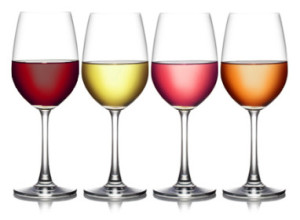Maceration Makes Me Blush.
(But It Can Also Make Me Red Or White Or Even Orange)
Chapter Twelve. Part Two.
Raise your hand if you think red grapes are filled with red grape juice. Raise your other hand if you think rosé or blush wines are made from pink grape juice. If you have both your hands raised, do the hokey-pokey and turn yourself around because almost all grape juice, whether from white or red grapes, is clear (which is more than I can say about my writing).
As long as I’m straightening out this whole color thing, let me add white grapes are really green, yellow or orange, red grapes are referred to as black but the liquid and skins combine to produce purple juice. Got it? You can put your hands down now.
Years ago when I was studying for a WSET exam I bought a book about fermentation but I found it pretty useless … until I decided to read it. If you want to learn a thing (or two) you’re going to have to click this little read more button…
The color of wine comes from the skins of the grape, not from the juice. For most white wine production, the freshly squeezed juice is separated from the grape skins before any color or tannin can be extracted. In northern Italy, where someone thought we need a new color to go along with red, white and pink, winemakers produce orange wine by leaving the juice in contact with the grape skins for hours, days or even weeks. These unique wines have been immensely popular – with about three sommeliers. The rest of us are reserving our opinion until Riedel releases an “orange wine” tasting glass.
For red wine production, the juice is left in contact with the skins, seeds and stems to impart not just color, but also aroma, tannin and flavor. Skin contact is referred to as maceration (so named because pubescent winemakers often experiment with skin contact). Maceration begins as soon as the grapes are squeezed (no metaphor intended), continues through the fermentation process, and at the winemaker’s discretion could extend well past fermentation.
The carbon dioxide that develops during fermentation pushes the skins to the surface of the fermentation vat, forming a cap that must be pushed down (or the liquid pumped over) to keep the juice in contact with the skin pigments. Cellar workers must be cautious not to succumb to the gas and fall unconscious into a vat of fermenting wine as this could pose a problem for vegan wine consumers.
Maceration, or more accurately, limiting maceration, is what allows white or pink wine to be made from black grapes. If you’ve tried some of the bold, black-hued Zinfandels coming out of California, you may find it hard to believe that they’re made from the same grape that produces the light, sweet and very popular pink wine known as White Zinfandel. This contradiction is possible because the length of maceration determines how much pigment leaches into the wine. Extended maceration produces opaque red wine whereas brief maceration periods ranging from a few hours to a few days will result in a pink-hued wine.
White Zinfandel is the result of a fermentation malfunction at the Sutter Home Winery in 1975. While attempting to make a dry style rosé from Zinfandel grapes, the fermentation stalled before reaching dryness. The result was a light, sweet wine that I find is best enjoyed on a summer afternoon by someone other than me. Although sales of this varietal are shrinking, Americans still drink about 20 million cases a year of the happy accident known as White Zinfandel.
Wine aficionados may snub their nose at White Zinfandel but the fact is they owe a debt of gratitude to its invention. The growing popularity of White Zinfandel in the late 70’s saved many of California’s precious old-vine Zinfandel vineyards from destruction. When red Zinfandel started gaining in popularity in the late 80’s, these valuable vineyards were still around to supply some of California’s best grapes.






















So we Red Zin drinkers owe a debt of gratitude to White Zin’s role in saving the Zin vines. Btw, I actually like Beringer White Zin with pizza!
As I once told one of my snobby wine salesmen; Americans don’t buy 20M cases a year of WZ because it tastes bad.